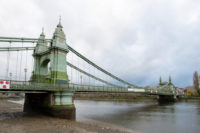Although taxpayers and benefactors spent $69 million on London's infamous Garden Bridge, no concrete was ever poured nor any metalwork formed. Planned as a privately financed venture, the project failed to secure enough backing.
The final toll was just revealed by Transport for London (TfL), the city’s transit authority, which itself spent $31 million on the canceled River Thames crossing. The Dept. for Transport’s share was $24 million including a third of it to project owner the Garden Bridge Trust.
The project to build a plant-laden, privately financed bridge in central London collapsed in summer 2017 after London Mayor Sadiq Khan declined to underwrite long-term maintenance in case the trust were to fail. A huge amount of design and preconstruction work had been done in the previous four years.
It was the brainchild of locally-based designer Thomas Heatherwick and popular TV personality Joanna Lumley, who persuaded then-mayor Boris Johnson and the government’s chief finance minister George Osborne to back the scheme.
TfL hired Arup Group to develop the design in 2013 with Heatherwick being appointed as its sub consultant. After the trust took over the project from TfL in 2015, it took on Paris-based Bouygues Travaux Publics S.A., with Italy’s Cimolai S.p.A., Pordenone, for preconstruction services.
Before securing all necessary financing, the trust then signed a fixed-price, design-build contract with the Bouygues team in 2016. In total, the contractor received payments of $27 million, including $6.5 million for preconstruction services and another $2.7 million for shutting the project down prematurely.
To act as a garden over water, the roughly 368-m-long structure in central London would have a deck widening to 30 m at two locations. Needing to support up to 2 m of soil on its 172-m main span, the deck depth would reach 6 m at the piers. The deck top would be sheeted with stainless steel. Its sides and large fluted concrete piers would be enclosed in cupronickel.





